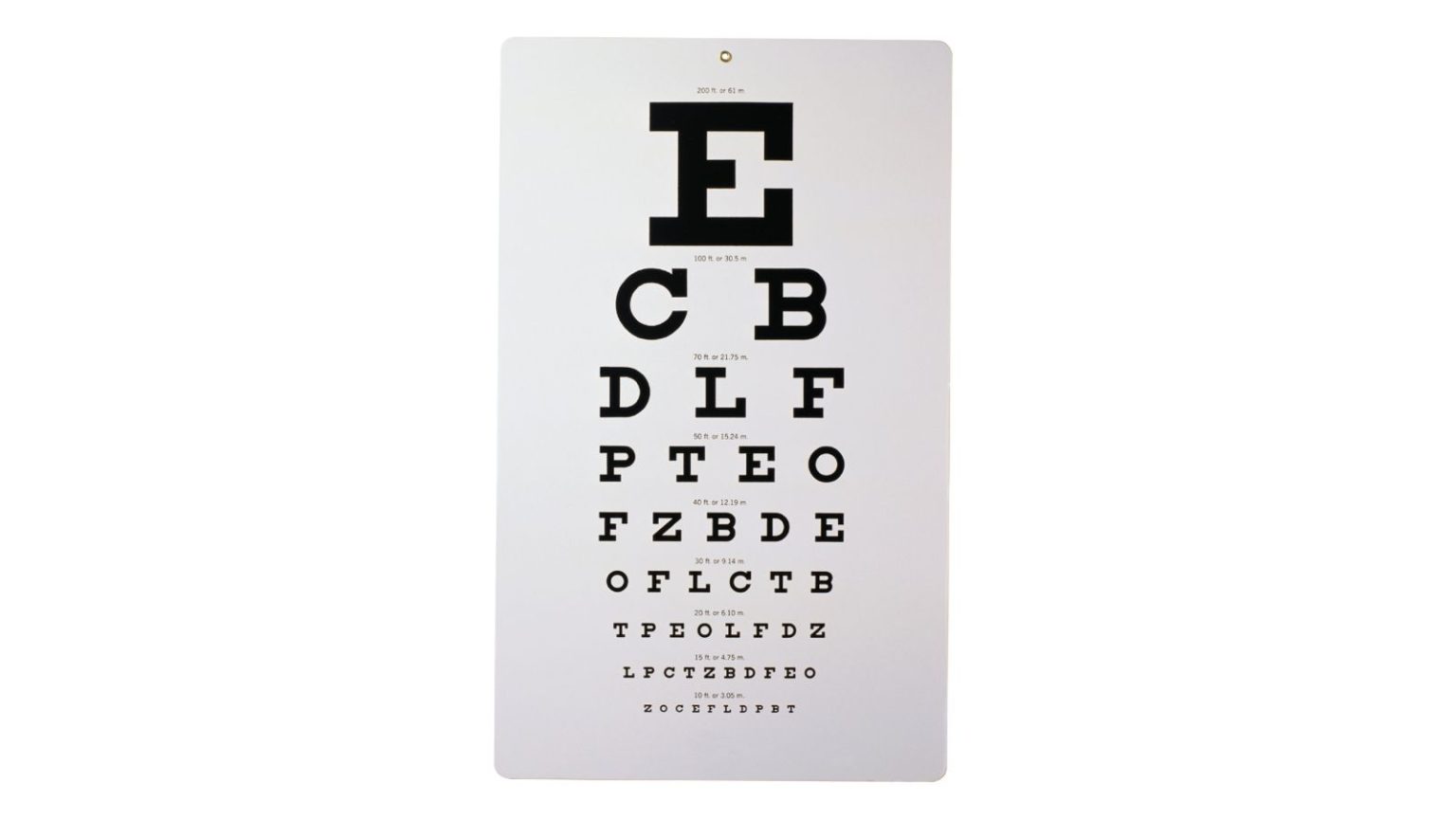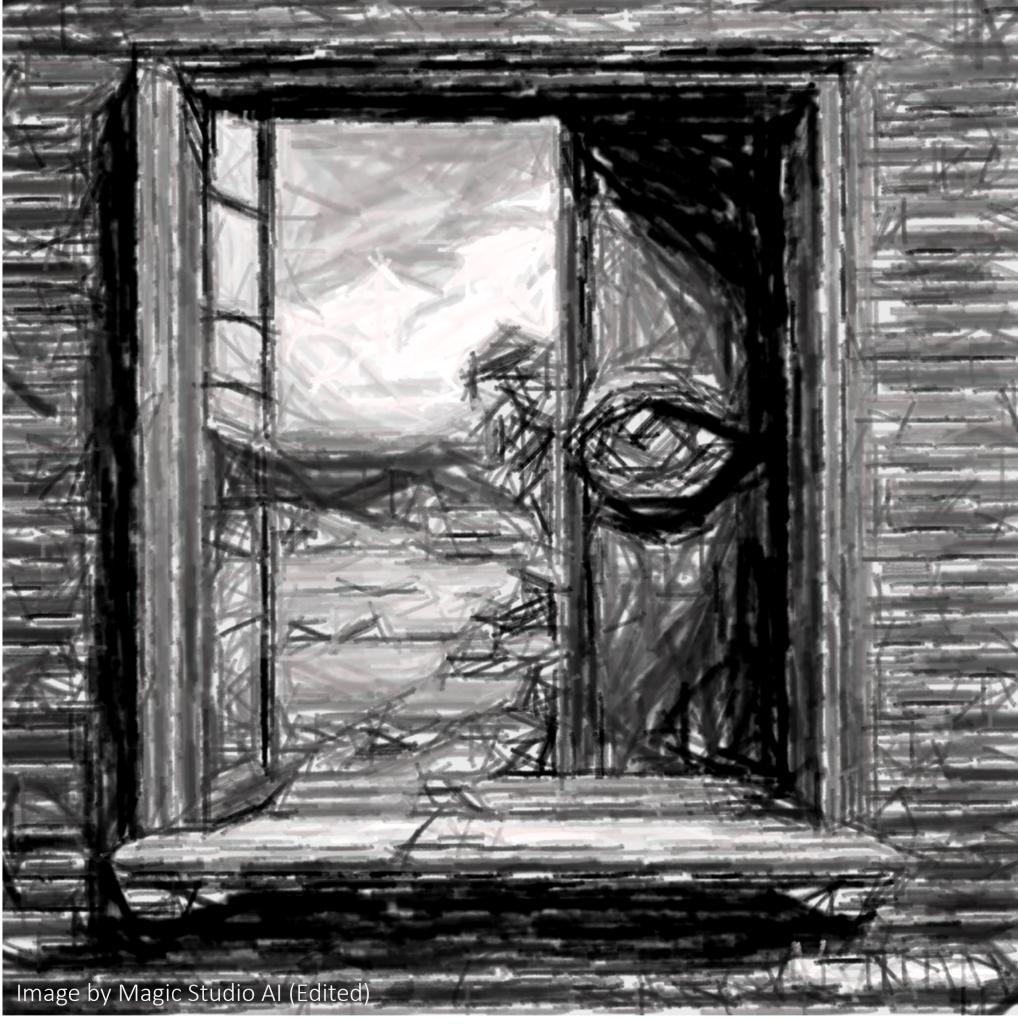6/6 or 20/20 vision compares visual acuity of a person’s eye with that of a hypothetical ‘normal’ human eye. Visual acuity refers to the ability to distinguish fine detail and distinctions between objects, with sharp edges and clarity. Humans are pretty good at this compared to most animal species on earth. According to a 2018 study in Ecology & Evolution, our eyesight clarity is roughly equivalent to chimpanzees, slightly better than octopuses, cheetahs, and giraffes, and exceeded by birds of prey (Figure 1). Factors like eye diameter, eye type, predation, and environmental complexity seem to play a part in the evolution of visual acuity across different species (Cave et al., 2018). For humans, variations in visual acuity are typically associated with refractive errors like myopia, and you might be familiar with terms like ‘degrees’ or read the word ‘Dioptre’ on your box of contact lenses.
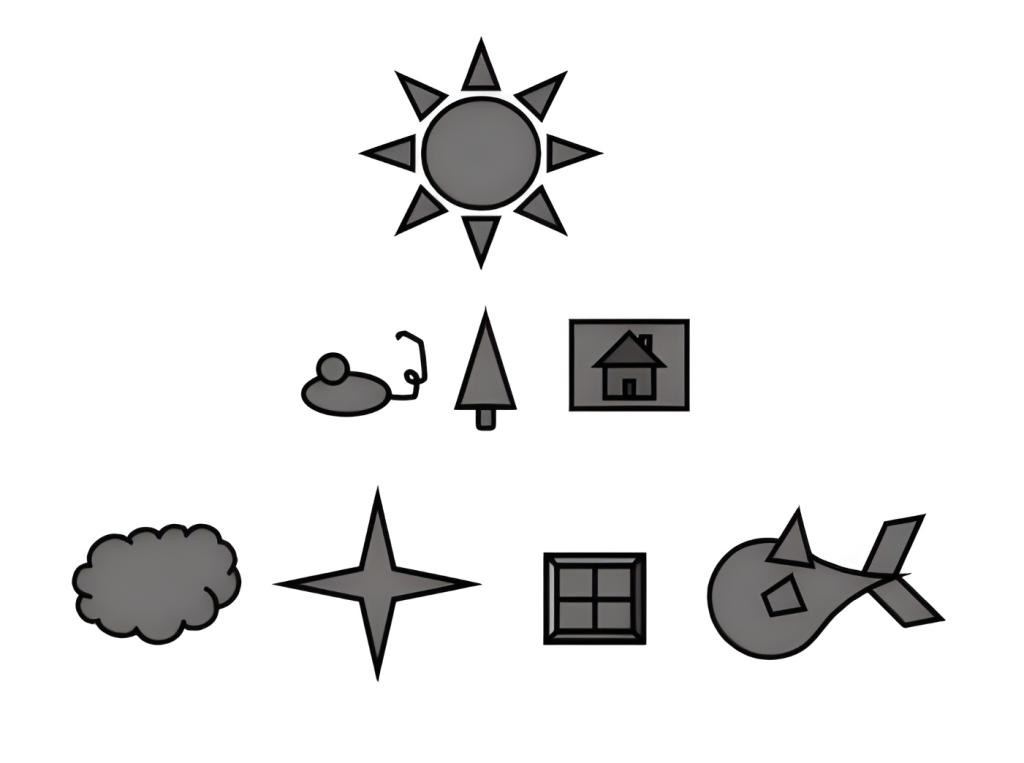
When you think of perfect vision, chances are what comes to mind is the phrase 6/6 vision, a term that’s often used to describe ideal or well-corrected eyesight. But is 6/6 vision truly the optimal measure of eye health and function? In the world of optometry, visual acuity is a critical measure of how well we see and thus function in our everyday lives, but it is not the only thing examined during an appointment. Colour blindness, ocular nerve and muscle function, corneal shape and health, as well as retinal cell counts are some other tests an optometrist might conduct for an eye examination.
So at the basic level: What does 6/6 vision mean, and how does this measurement differ around the world?
Image: Example of a Snellen Eye Test


The optometrist will control other factors like illumination and contrast. Speaking of contrast, the ancient Egyptians would gauge visual acuity by asking people to discriminate between two points on the Big Dipper: The stars Mizar and Alkor (In Kniestedt & Stamper, 2003). This method is rather inconvenient for eye examinations conducted in buildings during conventional work hours.
The numbers stand for 6 metres/6 metres or 20 feet/20 feet. While the common understanding of perfect vision is 6/6, it is possible for a person to possess a measurement of 6/3. The explanation of this number is that the person can see an image clearly at 6 feet which the hypothetical ‘normal’ eye could only see clearly at 3 feet. In reference to the expression ‘eagle-eyed’, eagles and other birds of prey are thought to have 6/1 vision. In the context of an eye examination, the letter chart is the tool used to test visual acuity.
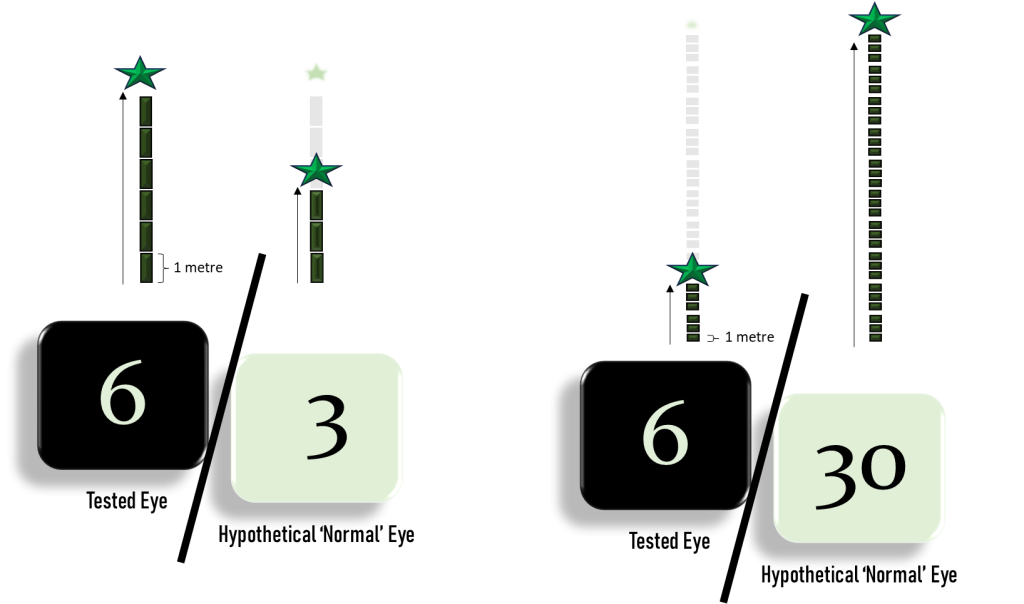
On the left: A patient’s tested eye can see clearly at 6 metres what the average/normal human eye could see at only 3 metres.
On the right: A patient’s tested eye can see an object clearly only at 6 metres, whereas a normal human eye could see the same object clearly at 30 metres.
A measurement of 6/60 for example would mean a person could be determined legally blind, as they would only be able to see at 6 metres what another would be able to see clearly at 60 metres. A person with this measurement would probably have difficulty seeing even the first row on a vision chart unaided.
Equivalent of 6/6 Vision in Other International Recording Systems
The notation 6/6 is used to measure visual acuity or sharpness of vision. It is a standard measurement commonly used in countries that follow the metric system, such as the United Kingdom, Australia, and many parts of Europe.
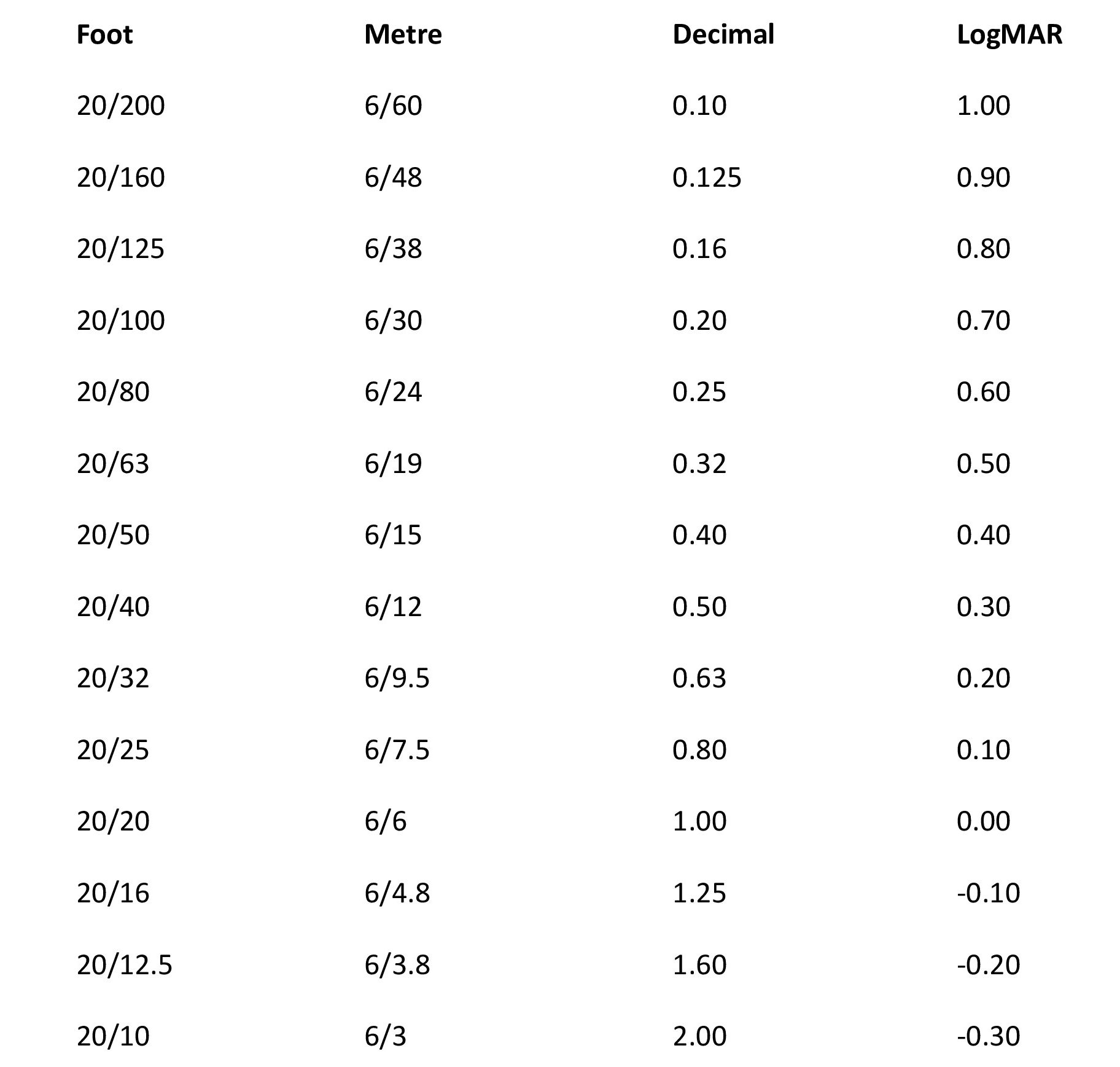
Conversion Table for Select Visual Acuity Measurements
1. 20/20 Vision
The most widely recognised term for normal vision in the United States is 20/20. In this system, the first number represents the distance in feet at which a person can read a specific line on the chart, and the second number refers to the distance at which someone with normal vision can read the same line. Essentially, 20/20 vision is equivalent to 6/6 vision, just in feet instead of metres. Thus, a person with 6/6 vision in the metric system would have 20/20 vision in the imperial system.
2. LogMAR
LogMAR (Logarithm of the Minimum Angle of Resolution) is another way to measure visual acuity, commonly used in research and clinical settings. It is a more precise scale compared to the Snellen chart and takes into account both the size of the letters and the spacing between them.
A LogMAR score of 0 represents 6/6 vision, as it indicates perfect visual acuity. Negative values in the LogMAR scale indicate better-than-average vision, while positive values represent worse-than-normal vision. For instance, a LogMAR score of -0.1 would correspond to better than 6/6 vision, while a score of +0.2 would indicate poorer than 6/6 vision.
3. Decimal Format
The decimal format is another system for measuring visual acuity, where 6/6 vision is represented as 1.0. This format is common in some European and Asian countries e.g. China, South Korea. A person with 6/12 vision, for example, would have a decimal score of 0.5, indicating that their vision is half as good as ‘normal’.
Other Factors
Properties such as object illuminance, patient pupil function, certain medications, or an ocular surface infection can all affect visual clarity. Therefore, during an eye examination the standard visual acuity test is combined with other measures and demographic data like age and even disease status (e.g. hypertension, diabetes) to ensure accurate problem detection and diagnosis. For example: Blurry vision in older adults could be due problems with cell health in the macula or fovea, areas at the very centre of the retina responsible for focused, sharp vision. Dry eye is another common culprit and comorbidity for myopes, which requires different tests and care.
Where the issue is refractive error and progressing myopia, precision really matters in terms of your prescribed spectacles or contact lenses. After all, as an elite amongst the earthly species in visual acuity (Cave et al., 2018), we should treasure our eyes and keep our vision as clear, sharp, and healthy as possible.
Feel free to contact us if you have any questions, or to make an appointment.
- Caves E. M., Brandley, N. C. and Johnsen, S. (2018). Visual Acuity and the Evolution of Signals. Trends in Ecology & Evolution, 33(5), pp. 358 – 372. https://doi.org/10.1016/j.tree.2018.03.001
- Keenan, T. D., Agrón, E., Keane, P. A., Domalpally, A., Chew, E. Y., Study, A. R. E. D., … & Age-Related Eye Disease Study Research Group. (2025). Oral antioxidant and lutein/zeaxanthin supplements slow geographic atrophy progression to the fovea in age-related macular degeneration. Ophthalmology, 132(1), 14-29. https://doi.org/10.1016/j.ophtha.2024.07.014
- Kniestedt, C. and Stamper, R. L. (2003). Visual acuity and its measurement. Ophthalmology Clinics of North America, 16(2), p. 155 – 170. https://doi.org/10.1016/S0896-1549(03)00013-0
- Kumar, P., Banik, S. P., Ohia, S. E., Moriyama, H., Chakraborty, S., Wang, C. K., … & Bagchi, D. (2024). Current insights on the photoprotective mechanism of the macular carotenoids, lutein and zeaxanthin: safety, efficacy and bio-delivery. Journal of the american nutrition association, 43(6), 505-518. https://doi.org/10.1080/27697061.2024.2319090
- Kaido, M., Dogru, M. Ishida, R., Tsubota, K.. (2007). Concept of Functional Visual Acuity and its Applications. Cornea, 26, p S29-S35. DOI: 10.1097/ICO.0b013e31812f6913, Thomson, D. (n. d.). The evolution of clinical vision assessment (Part 1). Optician Online. https://www.opticianonline.net/cpd-archive/6184/
Kalloniatis M, Luu C. Visual Acuity. 2005 May 1 [Updated 2007 Jun 5]. In: Kolb H, Fernandez E, Jones B, et al., editors. Webvision: The Organization of the Retina and Visual System [Internet]. Salt Lake City (UT): University of Utah Health Sciences Center; 1995-. Available from: https://www.ncbi.nlm.nih.gov/books/NBK11509/


